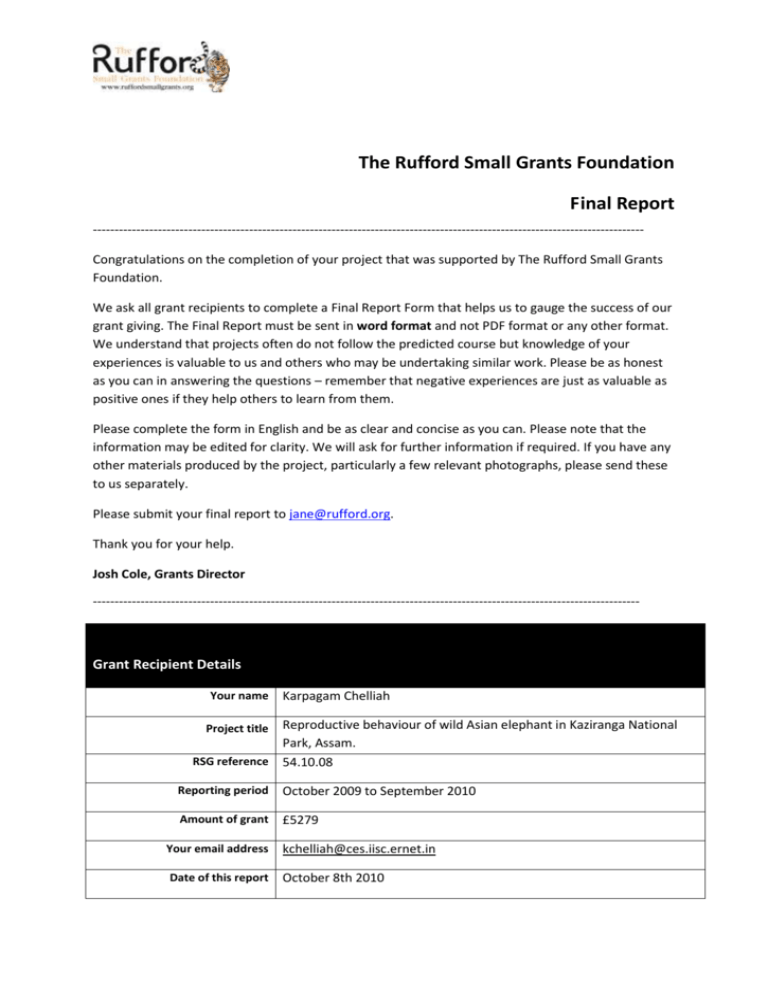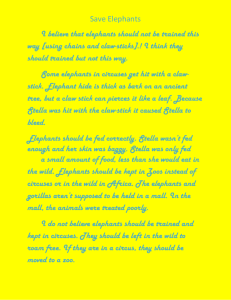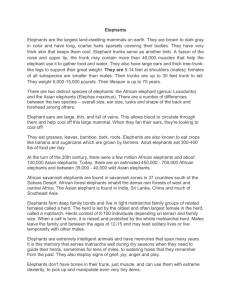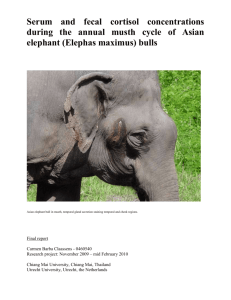Final Report - Rufford Foundation
advertisement

The Rufford Small Grants Foundation Final Report ------------------------------------------------------------------------------------------------------------------------------Congratulations on the completion of your project that was supported by The Rufford Small Grants Foundation. We ask all grant recipients to complete a Final Report Form that helps us to gauge the success of our grant giving. The Final Report must be sent in word format and not PDF format or any other format. We understand that projects often do not follow the predicted course but knowledge of your experiences is valuable to us and others who may be undertaking similar work. Please be as honest as you can in answering the questions – remember that negative experiences are just as valuable as positive ones if they help others to learn from them. Please complete the form in English and be as clear and concise as you can. Please note that the information may be edited for clarity. We will ask for further information if required. If you have any other materials produced by the project, particularly a few relevant photographs, please send these to us separately. Please submit your final report to jane@rufford.org. Thank you for your help. Josh Cole, Grants Director ------------------------------------------------------------------------------------------------------------------------------ Grant Recipient Details Your name Karpagam Chelliah Reproductive behaviour of wild Asian elephant in Kaziranga National Park, Assam. RSG reference 54.10.08 Project title Reporting period October 2009 to September 2010 Amount of grant £5279 Your email address kchelliah@ces.iisc.ernet.in Date of this report October 8th 2010 1. Please indicate the level of achievement of the project’s original objectives and include any relevant comments on factors affecting this. Objective Not achieved Partially achieved Adult sex-ratio (male:female) Adult tuskermakhna ratio Tusk length and shoulder height measurements of adult bulls Behavioural observations Fully achieved X Comments X 1:1 X X Between 1:3 and 1:5 Measurements have been obtained only for 31 males out of the 105 adult males sampled. The remaining 72 individuals were photographed at a distance larger than the range of the laser distance meter. We do not find support for our hypothesis that females prefer tusked males over tuskless males. 2. Please explain any unforeseen difficulties that arose during the project and how these were tackled (if relevant). The wild elephants were reacting strongly to captive elephant presence when we tried to follow herds through dense foliage. It was confounding my behaviour data. So I hired an extra field assistant and followed the elephants on foot. The elephants surprisingly habituated to our presence on foot more easily than our presence on a captive elephant. But this turned out to be very risky on three occasions. First, with an irate lone male buffalo, second with randomly running courting rhinos and third an accidental near collision with a sleeping tusker. The forest guard fired his rifle in the air and scared the charging animals away. 3. Briefly describe the three most important outcomes of your project. 1. Female elephants appear to be soliciting mating from multiple males. Currently prevalent hypothesis predicts that females should preferential mate with the best of all the courting males. The best male is expected to be the largest musth male with the longest tusk. However we have observed multiple matings and sometimes the female has to achieve this by sneaking away from a large, dominant, mate-guarding musth male in order to mate with a smaller, sub-dominant sneaky male. The females are not entirely indiscriminate either. They do avoid some males and solicit some other males. I have not been able to detect any consistent pattern in their choice. We do, however, have hypothesis as to why they may do so. One theory in biology states that multiple matings by females may be to ensure fertility (fertility-insurance hypothesis) especially in polygynous animals where males may suffer from sperm depletion. 2. Musth males are not indiscriminately aggressive. Aggression is tempered by social context. Scientific literature on African elephants and captive Asian elephant records repeatedly state that when bulls enter the musth stage (a temporary sexually heightened state in male elephants where plasmas testosterone levels are 50 times higher than normal) they turn very aggressive. However, what we found is that musth males are no more aggressive than non-musth males and that aggression if at all expressed was highly context dependent. We have observed adult musth males and non musth males exhibiting affliatory behaviour in the presence of the estrous female. We have even observed musth bulls forming coalition with non-musth bulls to guard estrus females from other sneaky bulls. We have not been charged even once by any of the musth bulls we followed. Often we were plum in their way but they just take a detour around us. This is in complete contrast to what is reported in African elephants. Therefore, the aggression observed in captivity, we belief is an artefact of captivity. A musth male in the wild, roves far in search of estrous females (as much as 10 to 15 kms per day). In captivity the musth male is unable to give vent to its natural instinct as it is kept chained to a spot and often kept semi starved to weaken its body condition. It is highly likely that when a gaol driven instinct of an animal is frustrated, it could trigger extreme aggressive behaviour. One way to test this would be to allow captive musth males to roam freely in the forest to search for estrous females. Off course this is easier said than done but with careful research and planning it is not impossible either. 3. Mate-guarding We have documented a rather puzzling behaviour by mate-guarding musth males. Often the musth male not only brings the estrous female to fairly open space such as the banks of large water body to guard against sneaky bulls but he also rounds up the entire herd of females and juveniles (like a cowboy rounding up cattle) and guards the whole bunch. We still do not have an explanation for this behaviour. 4. Briefly describe the involvement of local communities and how they have benefitted from the project (if relevant). This project generated stable employment for 8 months for at least two unemployed local youth. Their work experience with us in the forest may enhance their employment opportunity with the forest department or the tourism industry in the future. We have provided Assam forest department with a photo-data base of 103 adult bulls and 290 adult females. We have set up an easy lookup system to identify elephants in the database from photographs. We have made a short educational, documentary on the social elephants for children, from the video-footage of our research work. Free copies of this documentary will be distributed to schools around Kaziranga. The information centre at Kaziranga National park will also be given free copies of this documentary. 5. Are there any plans to continue this work? Yes. The research has generated more questions than answers. The reproductive behaviour of the elephants is much more complex than we thought. 6. How do you plan to share the results of your work with others? Our results will have credibility only if they are published in peer-reviewed, international scientific journals. Therefore our goal is to conduct yet another season of field work which we hope will yield statistically sufficient sample size to make valid inference. 7. Timescale: Over what period was the RSG used? How does this compare to the anticipated or actual length of the project? From late October till middle of May in the field and 4 months off the field processing data and making the educational documentary on elephants for children. Field work was less by a month than anticipated because of bad road conditions (early October – post monsoons and all of May with an unexpected early arrival of rains in Kaziranga) 8. Budget: Please provide a breakdown of budgeted versus actual expenditure and the reasons for any differences. All figures should be in £ sterling, indicating the local exchange rate used. Item Actual Amount 1600 Difference Comments Field assistant wages Budgeted Amount 800 +800 I hired two field assistants as it made my work easier Elephant hire 1674 0 -1674 I did not use captive elephants to follow the herd into dense foliage because wild elephants got disturbed by the captive elephant presence and it was confounding my behaviour data. It was easier to habituate them to our presence on foot. Vehicle fuel and maintenance Lunch for field assistants Kaziranga National Park fee Total 1860 1900 +140 744 1116 +372 200 400 +200 £5279 £ 5016 -263 Doubled because I had two field assistants instead of one. The forest guard fee for the park had doubled. 9. Looking ahead, what do you feel are the important next steps? I would like to publish our findings on the non-aggressiveness of musth bulls in a reputed scientific journal. This will give my work credibility. Then I would like to convince captive elephant owners that the extreme aggression displayed by their male elephants when they come into musth is not the natural behaviour of the animal. Finally, I would like to provide the captive elephant owners with a humane management plan for their male elephants when they come into musth as the current methods are in my opinion rather cruel. The alternate management plan has to be carefully thought out, experimented with on a few animals and if it works then it can be universally adopted. Our research findings from Kaziranga clearly show that females do have mate preferences and quiet often they choose to mate with more than one male. Majority of the captive elephants living near forest boundaries are indeed mated by wild elephants but as the female elephants are kept chained they may not be able to prevent being mated by a male not preferred by them. Here again, I would like to recommend alternate management plan that is developed on the basis of scientific principles. 10. Did you use the RSGF logo in any materials produced in relation to this project? Did the RSGF receive any publicity during the course of your work? Yes. When we screened the documentary “The Elephants of Kaziranga” in a national students’ conference on Ecology called YETI (Young Ecologists Talk and Interact). The logo also appears in the acknowledgement at the end of the documentary. I shall add the logo to the report I have to submit to Assam forest department and Ministry of environment and Forest, at the end of my research period. 11. Any other comments? The documentary “The Elephants of Kaziranga” was well received by the audience at YETI (Young Ecologists Talk and Interact) conference and that was encouraging. Many people requested for a copy of the documentary so that they could either screen it in some school or for their own children at home. We also got feedback from the audience to improve the documentary. The audio track has plenty of scope for improvement. Our aim is to translate this documentary into as many regional languages as possible over the years.










